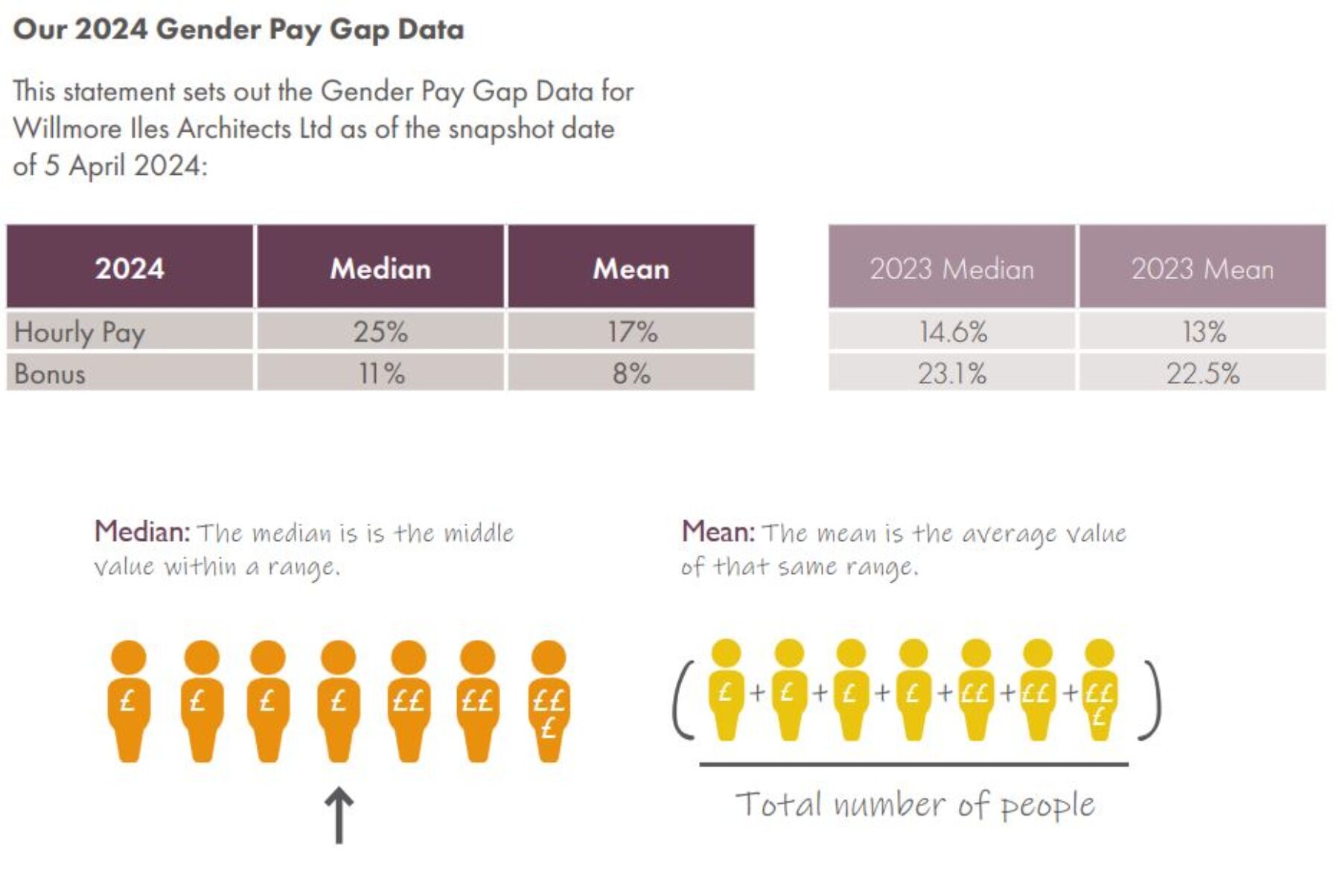Gender Pay Gap Report 2024
1.0 Introduction
Our Commitment to Gender Equality
At Willmore Iles Architects, we acknowledge our gender pay gap and are committed to eliminating it. Gender equality is integral to our core values, and we are dedicated to creating a workplace that reflects the diverse society we serve. We believe that fairness, inclusivity, and diversity enhance our creativity, strengthen our teams, and improve our architectural practice.
We recognise there is work to do, but our mission is to eliminate the gender pay gap by supporting every person, nurturing a culture of inclusivity, equality, and diversity within our practice.
The Gender Pay Gap reporting regulations came into effect on 5 April 2017, requiring UK organisations with over 250 employees to publish their gender pay gap data annually. While we are a practice of just 18 employees and not legally required to report, we choose to do so voluntarily as part of our commitment to transparency and accountability.
The number of employees at Willmore Iles Architects as at the snapshot date was 18, of which 9 were women (50%) and 9 were men (50%).
2.0 Gender pay gap reporting
Our 2024 Gender Pay Gap Data
This statement sets out the Gender Pay Gap Data for Willmore Iles Architects Ltd as of the snapshot date of 5 April 2024.
For context:
- The UK-wide ONS data (2024) median gender pay gap for all employees is 13.1%
- The average median gender pay gap (2023) in the ten largest UK architectural firms is 15%
- RIBA reports an average gender pay gap of 16% in UK architectural practices as of November 2024
It’s important to note that the gender pay gap is a measure of the difference in average earnings between men and women across our practice. It does not indicate unequal pay for equal work but rather reflects broader industry-wide challenges. Men and women are paid equally for performing equivalent jobs throughout WIA.

Understanding Our Gap
Our 2024 data shows an increase in our median gender pay gap, reflecting a challenging year. Global economic pressures led to project delays, structural changes, and a reduction in staff. Our senior leadership team remained proportionally larger to support upcoming structural shifts, contributing to an increase in the pay gap.
Our data highlights an imbalance in the number of women in senior roles, with women forming the majority in the middle-lower and lower quartiles.
All our permanent employees are eligible to receive a bonus as part of our EOT and profit share scheme. While the gender pay gap has increased this year, we’ve seen an improvement in our bonus pay gap. Notably, the percentage of people receiving a bonus is in favour of
females, as the Directors did not take a bonus this year.
3.0 Addressing the gender pay gap
Our Action Plan
We remain committed to reducing the gender pay gap. Our analysis shows that the primary driver of our gap is the higher percentage of men in senior positions. To address this, we continue to review, evaluate and adapt our action plan. This is a structured, evidence-based action plan aligned with RIBA’s #CloseTheGap initiative and the UK Government’s recommendations for reducing
gender pay disparities.
Our Five-Point Gender Diversity Action Plan:
1. Diversity Working Group
2. Transparency & Feedback
3. Inclusive Recruitment
4. Training & Mentorship
5. Retention & Career Progression
Progress and Future Actions:
To date we have made meaningful progress, including:
- Championing a fully engaged ED&I (Equity, Diversity & Inclusion) group.
- Implementing blind recruitment practices and reviewing job advertisements to remove biased language. We’ve also improved our interview and selection process in line with RIBA’s Close the Gap recommendations.
- Becoming a B Corp, with a focus on aligning with sustainable and inclusive practices.
- Continual commitment to the RIBA Inclusion Charter
- Developed an internal framework to ensure fair process for all employees
- Continuously reviewing all policies and making necessary updates. As well as identifying gaps, for example we have implemented a menopause policy and will be implementing a menstruation policy imminently
- Introducing a hybrid working model and flexitime to support work-life balance, ahead of implementing mandatory policies to support staff with caring responsibilities
- Reporting on ED&I at monthly meetings and creating an ED&I calendar
- Providing ongoing training and support through 1:1s
- Developing a ‘Return to Work’ programme for employees returning from family / long-term leave.
- Continuously monitoring, evaluating, and adapting our approach to make meaningful progress.

4.0 Looking forward
We recognise that the gender pay gap can widen before it narrows, particularly in smaller practices, and that meaningful structural change takes time to embed.
We firmly believe that meaningful progress requires sustained effort and collaboration. With the continued engagement and determination of our employees, our aim is to build on past successes
and take further steps toward reducing our gender pay gap in the years ahead.
We recognise there are broad and complex social issues underlying the gender pay gap, and reducing it will take time. However, we are committed to achieving this over the coming years through our transparent, target-driven action plan, which allows us to track our progress and hold ourselves accountable. By sharing our data and strategy, we aim to contribute to a wider industry shift toward equality, ensuring that at Willmore Iles, architecture is a profession where everyone has the opportunity to thrive.
See our GPG Report below
-
WIA-2024 GPG Report
Download (468.60 Kb)